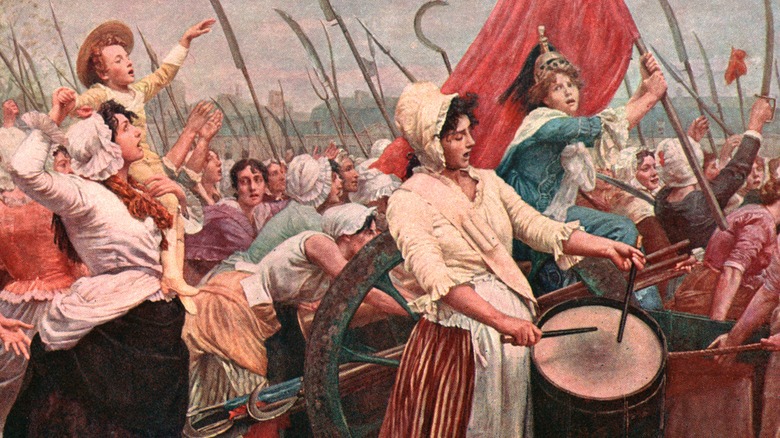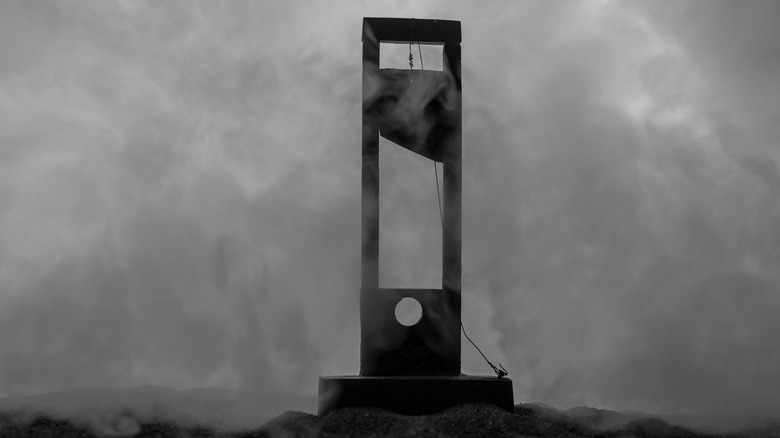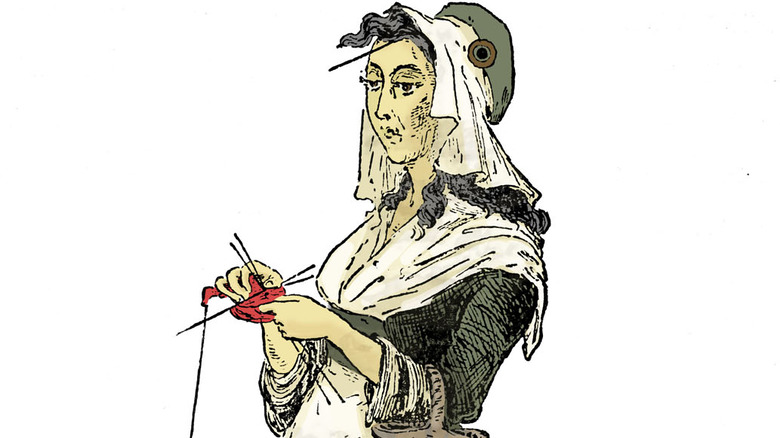The Women Of The French Revolution Who Had A Weirdly Morbid Pastime
The French Revolution was filled with days burned into the history books and passed down over the years. One such day was the Women's March on Versailles on October 5, 1789. According to an article published in History Daily, the march began after a group of women went to a market, only to find that the cost of bread had become unreasonably high. The raised cost of food led them to protest by marching to city hall. Once at city hall, the angry women stole weapons and any food they found.
The cause quickly grew into the thousands, and King Louis XVI was given little choice but to not only move to the Palace of Tuileries in Paris with his family but also adhere to the demands of the protesters, per an article published in Geri Walton. These women from the market who were standing up for the right to accessible and affordable food were praised for their tenacity and began receiving invitations to important and extravagant events, though before long the fierce women began bullying aristocrats in the streets and exhibiting a pattern of aggressive behavior that the government did not favor. Soon the once-praised group of rebels became banned from any government proceedings and were told that any political assembly they may form going forward would be unlawful.
The rebellious women gathered around the guillotine to knit
The ban from proceedings and political assembly didn't mark the end of the women's cause, and they quickly found a new, much more morbid way to gather. They began to get together at the Place de la Révolution, which happens to be the square where everyone from everyday petty criminals to prominent figures were executed by guillotine. While public executions were just a way of life back then, with many gathering to witness what was considered the law at work, the women took it a step further by bringing chairs to hang out near the guillotine itself and shout during the beheadings, according to Geri Walton.
As a means to pass the time, knitting became a popular activity between each execution, and the women would station themselves in the square and work away on an intricate yarn project while waiting for the subsequent execution to take place. However, this ordinarily wholesome activity became much more unsettling given the circumstances, and the group of women, once known as the Mothers of the Nation, earned themselves a new title: tricoteuse, meaning a woman who knits (via Spin Off Magazine).
The tricoteuse became well-known for their rather morbid hobby
While the tricoteuse were busy with their knitting and heads were quite literally rolling from the executions, the women's reputation was growing. Throughout the revolution, the crafty women created a plethora of items, including the famed liberty hat. This hat was a red stocking cap that became a symbol of freedom, and according to Geri Walton, even King Louis XVI was made to prove his loyalty by wearing one.
Rumors surrounding tricoteuse grew, and some were even immortalized in the form of literature, as Charles Dickens wrote in "A Tale of Two Cities" that the tricoteuse women would knit the names of those being executed into whatever project they were busy with. Dominique Godineau wrote in "The Women of Paris and Their French Revolution," "A woman who knits conjures images of warmth, rest tenderness, and love; in the calm of the living room, she works for others. The tricoteuse, however, evokes feelings of violence, hate, death, and blood; before the eyes of everybody and in the public tribune, she ignites." Godineau continues her dark take on the acts of tricoteuse by referring to knitting needles as "...dangerous; weapons without names; tools for labor tinged with bloody tips."
The tricoteuse made a significant impact during the French Revolution. Their reputation for having a rather morbid crafting location only added to their power and influence.


